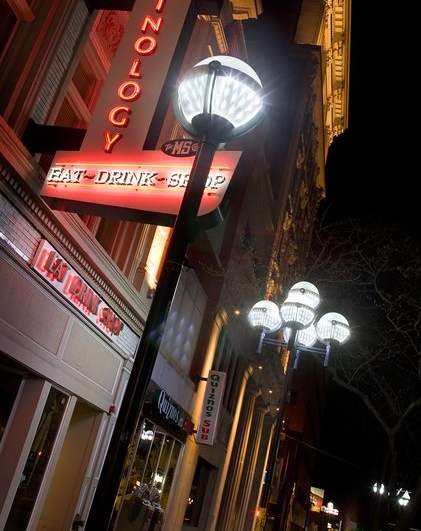Tough Road to Getting LED Lights on the Streets

Apr. 15, 2013 PLYMOUTH VOICE.
According to a recent press release from the office of City Manager Paul Sincock, Plymouth is continuing to test different styles of retro-fitted LED street lights. The city is considering a proposal from DTE Energy to retro-fit all of the DTE residential street lights with new LED light fixtures. The following is reprinted from National Geographic Daily News, first published Jan. 20, 2011.
By Josie Garthwaite
Photo by Tom Drew
Power plants may not spring to mind during an evening stroll on a well-lit block, or when an overhead lamp burnout darkens a treacherous bend in the road. But power plants indeed provide much of the world‘s nightly abundance of electric light, usually by burning fossil fuel and adding greenhouse gases to the atmosphere along with the glow. And cash-strapped cities foot the bill.
According to the Clinton Climate Initiative, street lighting accounts for a staggering 159 terawatt hours of electricity use worldwide each year. That’s more than the annual output of three dozen 500-megawatt power plants. And although street lighting accounts for less than one percent of all electricity use in the United States (it’s about 1.3 percent in the European Union), this comes at a hefty cost for cities. In some areas, street lights command upwards of 60 percent of municipal electricity spending.
So in tough economic times, municipalities have begun to pull the plug on inefficient lamps in favor of long-lasting, highly efficient light-emitting diode (LED) technology. In the United States, many of these projects have been supported by economic stimulus block grants for energy efficiency and conservation projects.
According to the U.S. Department of Energy, LEDs could help communities save more than $750 million per year in energy costs, while also offering benefits like more uniform light distribution. Around the world, LEDs are lighting streets from Torraca, Italy, to Toronto, Canada, and from Tianjin, China, to Sydney, Australia. Yet, in the big picture, the Clinton Climate Initiative report notes “negligible” adoption of new lighting technologies by cities. When cities do seek to cut energy costs by converting old streetlights—many of which are non-metered and owned by the local utility—they often encounter a rocky road ahead.
Not Just Screwing in a New Light Bulb
LED streetlights cost more up front than incumbent high-pressure sodium, mercury vapor, and metal halide lights. Partly because the technology is changing quickly, long-term performance in real-world installations is also unproven. “There are a lot of unknowns in terms of maintenance,” said Ed Henderson, who runs a system of 200,000 streetlights in southeast Michigan as manager of community lighting for utility DTE Energy.
Whereas replacing a traditional streetlight in DTE’s network is typically as simple as unscrewing a dead bulb and screwing in a new one, said Henderson, LEDs can come in a variety of packages, and they’re changing all the time. “Like cell phones and flat screen TVs, there’s an obsolescence factor,” he said. “When we put an asset up there, we want it to be up there a long, long time.” The more “one-off” or specialty installations, the more difficult maintenance becomes for a utility managing streetlights on a large scale, he said.
Yet reduced costs for energy and, crucially, maintenance over the working life of LED streetlights (as long as 10 years for some models) mean they can “pay for themselves” in seven years or less, depending on factors like wattage, electricity rates, and labor costs. “As long as the warranty is longer than the payback,” said Andrew Brix, energy programs manager for Ann Arbor, Michigan which expects a four- to five-year payback on LED streetlights with a seven-year warranty, “I’m happy.”
Ann Arbor has worked to iron out the kinks of LED streetlight installations over the past few years. Back in 2007, the city drew national attention with plans to become the first U.S. city to convert all of its downtown streetlights to LED technology. Replacing 120-watt bulbs with 56-watt LEDs that were expected to last a decade instead of only two years, the project was projected to shrink the city’s public lighting energy use by half, cut maintenance costs by about $85,000 per year and save another $15,000 in annual electricity costs, according to Ann Arbor’s estimates at the time.
Two years later, however, DTE was still billing Ann Arbor at the old rates—as though the LED streetlights were using as much energy as their less efficient predecessors. Since the lights weren’t (and aren’t) metered, charges were based on estimates, which in turn were based on the older technology.
Similar issues halted an LED streetlight project in nearby Jackson, Michigan, last year. Having determined that installing LED lights will not cut electricity bills until the local utility, Consumers Energy, develops a new rate, City Engineer Jon Dowling said Jackson has for the time being dropped plans to pursue the technology.
In Washington, D.C., by contrast, where a $1 million grant from the economic stimulus program, the American Recovery and Reinvestment Act, will support installation of LEDs for more than 1,000 streetlights this year, the District’s streetlight utility bills are based on the bulb’s wattage. So according to John Lisle, spokesperson for the District Department of Transportation, D.C.’s selection of a 73-watt LED light to replace a 150-watt high-pressure sodium light, for example, will cut both energy use and costs by about 50 percent.
Low-Wattage Sticker Shock for Power Companies
Further complicating matters for ambitious LED streetlight supporters is the fact that many streetlights in U.S. cities (5,000 of Ann Arbor’s 7,000 lamps, for example), are owned by the local utility, while the municipality pays for the electricity and operating costs. Because most utilities bring in money based on the amount of energy they sell, changing over to more efficient lamps would therefore reduce the utility’s revenue.
This is where a policy known among energy and efficiency wonks as “decoupling” comes into play. In California and at least 12 other U.S. states, regulations have decoupled utility profits from electricity sales, creating a mechanism for utilities to make up for some of the revenue they would lose as electricity sales decline, and in some cases offering incentives for efficiency programs. California utility Pacific Gas & Electric offers rebates for LED installations and has established rates for different lamp types, a move that trade publication LEDs Magazine hailed in 2009 as “an example for utilities across North America.”
In Michigan, the state utility regulator ultimately directed all Michigan utilities to put together a rate for LEDs. Today DTE Energy charges Ann Arbor rates based on the LED streetlights’ expected energy use, under a larger category for experimental lighting technology. The utility credited the city for the lower energy use retroactive to the installation, and today Brix says the city has saved about $200,000 as a result of the downtown streetlight installation, combined with the first few months of additional LED streetlight projects throughout the city. “Getting billed properly for city-owned streetlights is important, but only accounts for one-fifth of the savings,” said Brix. The rest comes from reduced maintenance costs.
Out of 7,000 streetlight fixtures citywide, Ann Arbor has about 1,400 LEDs, saving an estimated 350,000 kilowatt-hours per year—about equivalent to the amount of electricity used by 50 average Ann Arbor homes, according to Brix. Out of the 200,000 streetlights that DTE owns and operates throughout southeastern Michigan, about 1,000 use LEDs, said Henderson, noting a goal to bring that up to 4,000-8,000 (2-4 percent).
Back in 2007, the city approached DTE and said, “Hey, we want to do LEDs,” Brix recalls. The utility “came back and said they needed to get their own hands-on experience with what was, at the time, still a pretty new technology,” he said. “What has changed since then is that the industry is maturing and we have more standards and specifications we can rely on now, so that going forward we won’t have to do those tests.”
Much larger LED streetlight installations are in the works. San Francisco, California, for example, issued a request for proposals late last year to replace 18,500 high-pressure sodium “cobra-head” streetlights owned and maintained by the city and county. Looking to go beyond the basic benefits of greater efficiency and longer life, San Francisco envisions a wireless monitoring and control system being integrated into dimmable LED luminaires.
Henderson sees the capability for controls and dimming as an exciting part of the future of LED streetlights. Regarding late night and early morning dimming, he said, “Other parts of the world do that for energy savings,” offering Paris as an example. “If people can’t get comfortable with that” electricity needs could be further reduced, and the LEDs would last even longer, he said.
For now, Ann Arbor still spends about $1.5 million annually on streetlights. Brix considers it “a big ask” to propose a new technology for utility-owned streetlights that would save the city money. “They need to be comfortable with it,” he said. By the end of 2011, Brix said Ann Arbor expects to double its streetlight energy savings by installing 500 LED fixtures as replacements for high-wattage streetlights. And with a goal to bring streetlight costs below $1 million per year, said Brix, “we’re just going to keep plugging away, putting in LEDs as soon as we’ve got the funding.”
|News Plymouth Michigan



